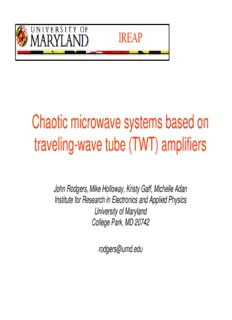
Chaotic microwave systems based on traveling-wave tube (TWT) PDF
Preview Chaotic microwave systems based on traveling-wave tube (TWT)
IREAP Chaotic microwave systems based on traveling-wave tube (TWT) amplifiers John Rodgers, Mike Holloway, Kristy Gaff, Michelle Adan Institute for Research in Electronics and Applied Physics University of Maryland College Park, MD 20742 [email protected] Concept: Networks of coupled chaotic time-delayed oscillators (TDO) High-power Output Directional Traveling-wave Coupler Device Dynamic Control Delay Line Variable Atten. •The radiation scattered off objects will couple in varying strengths to the various nodes of the network and modulate its dynamics. Basic Research Questions • How robust would synchronization in the network be in the presence of: – Noise – Mismatch in the dynamical parameters of the nodes – Interference or jamming – Complexity of the environment Changing Environment Traveling-wave Traveling-wave Device Directional Directional Device Coupler Coupler Dynamic Control Dynamic Control Variable Atten. Variable Atten. Delay Line Delay Line IREAP Outline • Basic characteristics of the traveling-wave tube (TWT) • TWT nonlinearity • Saturation models • Results of previous simulations • Results of experiments on TWT’s with time- delayed feedback • Digital control of the time-delayed system • Future research TWT Basics Slow space charge wave ω= k v z Slow EM wave TWT Dispersion Diagram •Properties: High gain, wideband, good linearity and efficiency •Applications: Space communications, secure LOS, cell phones, radar, EW Typical characteristics of the TWTA Depressed Pierce Gun Collectors SWS 20 cm PPM Stack •High gain 40-60 dB •Wideband >2 octaves •Compact m~ kg, L< 12 cm •Efficient >80% (Dep. Coll.) •High Frequency >50 GHz •Modest Voltage ~few kV Nonlinearity in TWT’s (1-D Model) RF field on helix Modulated electron beam ∂v ∂v e ∂(V +V ) Over-modulation of Equation of Motion = −v − W SC the beam increases ∂t ∂z m ∂z ∂ρ ∂(ρv) space-charge forces Continuity = − which saturate the ∂t ∂z amplifier. ∂2V ρ Gauss’s Law SC = − ∂z2 ε 0 Wave Equation ∂2V ∂2V ∂2ρ W −c2 W = cZ A ∂t2 ∂z2 0 ∂t2 TWT Gain Saturation Gain-Bandwidth Gain and Output Phase vs. Input Power Small signal 2 -40 dBm -30 dBm 45 0 -20 dBm Gain -15 dBm 50 30 B] -2 -10 dBm d g] [ -7 dBm n [dB] 015 Shift [de ed Gain --64 -5 dBm Gai40 Phase se aliz -8 Fund. Gain -15 ha m P r 2nd Harm. Gain o-10 -30 N Highly Saturated Phase 2nd Harm. -12 30 -45 -50 -30 -10 -14 Drive Power [dBm] -1.2 -0.8 -0.4 0 0.4 0.8 1.2 Offset Frequency [GHz] In some TWT’s, saturation is well described as a quadratic function the of input amplitude and the small-signal bandwidth as a first-order band pass filter (BPF). Comparison of measured TWT drive curve with best fit to Saleh1 model 30 y = A(r)e− jΦ(r) Measurements | y | α r e A(r) = a d 20 u 1+ β r2 t Saleh Model i l a p m α r2 A φ t 10 Φ(r) = u p (1+ β r2)2 t u φ O 0 0 0.01 0.02 0.03 0.04 Input Amplitude (r) 0 i 05 1. A. M. Saleh, IEEE Trans. Comm., Vol. 29, No. 11, (1981), pp. 1715-1720. Model of a Time-delayed Feedback Oscillator Using Linear and Nonlinear Blocks to Describe the TWT (see poster presented by Wai-Shing Lee) Linear Gain (G ) + L First-Order BPF Saturation Nonlinearity 2. V. Dronov, M. Hendry, T. M. Antonsen, Jr., and E. Ott, Chaos, Vol. 14, No. 1, pp. 30-35, 2004.
Description: